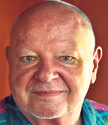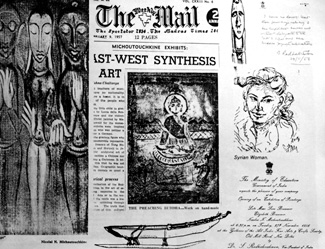It was a rare coincidence and a simple telephone call that made two wide and varied paths, with an underlying common thread running through them, forged half a world away, cross nearly half century later.
In a sense, it was meant to be and the joy of the reunion was obvious when we met them in Negombo recently at the cosy home with paintings on all walls of Sri Lankan art maestro George Beven.
The story unfolded over the delicious breakfast of thick pol-rotti, beef curry and pol-sambol.
While Octogenarian Beven wondered whether Nicolai Michoutouchkine, 80, was still alive, the same thought had crossed Nicolai’s mind too. It was then that Beven contacted some cousins in Brisbane, Australia, who were to visit the South Pacific who became the link in re-establishing the bond.
 |
| Nicolai Michoutouchkine |
Nicolai was traced to Vanuatu in the South Pacific where he and partner Aloi Pilioko have set up a major collection not only of paintings but also of crafts and sculptures, the mission begun by Nicolai in the 1950s which brought him to Sri Lanka too where Beven’s and his path crossed.
It started with a spiritual journey way back in 1953. Born to Russian parents in France in 1929, “Nicolai graduated from a commerce school but felt a yearning, for he had read varied writings not only by Mahatma Gandhi and Rabindranath Tagore but also about Tibet.
Meant to be a six-month artistic pilgrimage, he set off “without a penny in my pocket”, hitchhiking overland -- Switzerland, Italy, Greece, Turkey, Syria, Lebanon, Egypt, Jordan, Iraq, Iran, Afghanistan, Pakistan and finally India. As he travelled, he also painted.
“I held my first art exhibition in Jerusalem,” says Nicolai, adding that it was then still an Arab state. He was 26.
It was India that held him, its vastness and diversity an enchantment and he exhibited his works in New Delhi having been sponsored by the French Embassy. It was also in India that he teamed up with artist Elizabeth Brunner who had come with her mother to meet Tagore.
But it was after a memorable trip to the world famous sculptural site of Kajuraho that his life’s journey was forged. All artists who had been on a visit there decided to meet at the railway station to get back to Delhi.
 |
| Nicolai’s impression of the Buddha done on mats--painted during his time here in the 50s featured in an Indian newspaper |
Nicolai was there and Elizabeth rushed up with her bedding et al only to find that the train had already left. No one else had turned up. What could they do?
On the spur of the moment the duo decided that they would get on the first train that arrived whatever its destination. It was a long wait of eight hours and the train that pulled up at the platform was not heading for Delhi but to Benares.
“Things started happening after that,” says Nicolai. It was to Benares that they went and on to Calcutta, from temple to temple, sketching and painting. By this time, his visa had expired so he crossed over to Nepal and was the first European to exhibit his works there. “The exhibition was opened by the King,” he says.
All the cultural activity began then, not only painting but also collecting items from local artisans.
Crossing back to India, he vividly remembers 1956 – the year of the Buddha Jayanthi celebrations when he and Elizabeth decided to embark on a journey to all Buddhist places of worship on a sketching expedition.
So it was to Burma they went first, returning to India after a very fruitful voyage.
By that time, the World Buddhist Council extended an invitation to them which saw them coming across to Sri Lanka and forming a friendship with Beven, travelling far and wide from Galle to Kandy to Anuradhapura, seeing the wonders of the ancient cities and sketching to their hearts’ content.
“My exhibition in Colombo was opened by then Prime Minister S.W.R.D. Bandaranaike,” recalls Nicolai explaining that they even had tea with the PM and his family at Rosmead Place. “Top people were very accessible and there was no security like now.”
They also exhibited their works in Kandy and Galle on the invitation of then Minister W.D. Dahanayake. Galle was memorable because as many as about 12,000 thronged to see the Buddhist sketches.
Around this time, Nicolai was expected to do military service but with the eruption of the Suez crisis he found it impossible to board a ship from Sri Lanka to get back to France. The French military was benevolent and gave him time till October 1957 and also the choice of joining a French territory.
It was a toss up between Madagascar and New Caledonia and it was to New Caledonia that he went, holding exhibitions in Australia. With the military service behind him, he set up the first art gallery in New Caledonia where he had teamed up with Aloi. The region fascinated him and held him captive for two years after which he went to Futuna island. Then came an invitation by the French resident commissioner to come to New Hebrides which later became Vanuatu. “There I organized a big exhibition of Polynesian artifacts,” he says.
So Vanuatu became home with a piece of land by the sea. “This is a bilingual country and a meeting place for Melanesians and Polynesians and reminded me of Ceylon, which country I had fallen in love with in the 1950s,” he says.
Many are the invitations Nicolai got from important people to exhibit his works in Australia, Japan, Indonesia, France and Russia (where he met up with long lost relatives) to name a few not only pursuing his career as an artist but also helping local craftsmen and painters.
Vividly he recalls 1967, when they exhibited 700 pieces of art from Oceania in an abbey east of France. “There were totems and drums where the altar was.”For the last 30 years, he and partner Aloi, “a bond which has lasted 50 years” have been in Vanuatu, having their own gallery where they also display other artists’ works and encourage the youth to train as artists by holding workshops.
This versatile artist fluent in many a language such as Russian, French, German, Italian, Greek, Arabic, Pidgin and of course English says he indulges in colourful art depicting sceneries, the life of the people because there is a richness in it.
Nicolai puts it all down to that Asian pilgrimage, so long ago and its extraordinary encounters. “This is all due to the inspiration I got from Asia,” stresses Nicolai, reminiscing about the vivid rice decorations on the floor he saw in places like Sri Lanka.
|



